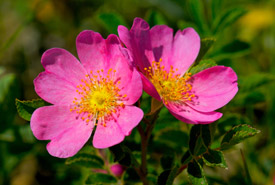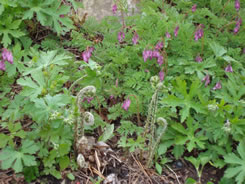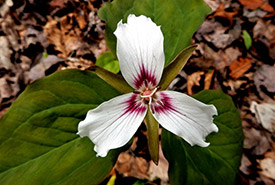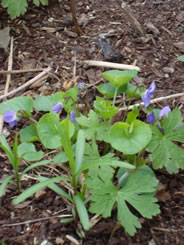Native gardening 101

Prairie rose (Photo by Karol Dabbs)
Support biodiversity by naturalizing your garden with native plants
By introducing native plants and some strategic design features to your garden, you can provide patches of natural habitat for many species. A well-designed backyard offers birds and pollinators — like butterflies — more living space, feeding opportunities and cover from predators.
By enhancing and restoring natural elements in your garden, you'll make the urban landscape more wildlife-friendly.

Shield fern and fringed dicentra (Photo by NCC)
Where to begin?
Before you start, find out what kind of soil you have and which plants are native to your area. Consult a guidebook to native plants for your region, or one of many of good websites to help you determine native plants in your area. Visit local nurseries or seed suppliers to determine what native plants are available; this will give you a better idea of what to put in your garden. Consider a combination of plants that will flower from spring through fall, as they provide pollen and nectar for wildlife throughout these seasons.
Also, think about the desired long-term look and feel of your backyard. Are you drawn more toward an open, sunny space filled with a meadow or prairie garden? Or is a shaded woodland garden more to your liking?
Resources
Check out this plant database to find out plants that may be suitable for your area.
Find out more about selecting plants for pollinators in these ecological planting guide.
Visit the North American Native Plant Society's directory to learn more.

Painted trillium (Photo by Jacques Ranger, CC BY-NC 4.0)
A native plant garden isn’t just about planting herbaceous plants, it’s also about incorporating native shrubs and trees. If you're planting trees, consider their size at maturity and whether they will still be suitable for the space in 20, 40 or even 60 years. Consider their position relative to overhead wires and nearby buildings. As well as the plants, plan for other features, such as a small pond with trickling water to attract birds and perhaps even a few frogs. Or consider a small brush pile to provide cover for small birds, such as winter wrens as they migrate through neighbourhoods in spring and fall.
Once you've considered these questions, you’re ready to begin sourcing your plants.
Sourcing plants
Plants can be sourced from a local garden centre, or as seeds from a local seed supplier. Ask garden centre staff about where their plants are grown. Many nurseries import plants from hundreds or even thousands of kilometres away. While they may carry the species you are looking for, the selection (if imported) may not be hardy to your backyard conditions. It's best to find a nursery that can guarantee that its plants have been grown locally. You should also ask them whether the plants you have selected were propagated under cultivation and not dug out of the wild. Seed suppliers should also have acquired their seeds locally and ethically.
Maintaining your garden
Although a naturalized garden may be less formal than a manicured garden, they're not necessarily maintenance-free. If done well, a naturalized garden may require less watering and be able to survive periods of drought more easily. However, until it is well established, you'll need to give it some maintenance, including careful watering during droughts. Urban neighbourhoods often have significantly lower water tables than natural landscapes, so it’s important to water plants during extended dry spells.
Native plants are also often better adapted to the local climate and exhibit a higher tolerance to pests than many garden ornamentals. As a result, naturalized gardens can thrive without the use of pesticides. In fact, a naturalized garden will attract "beneficial" insects that are predators of other pest species.
If invasive weeds are not removed on a regular basis, they will compete with the native plants in your garden and can spread to nearby natural areas. You may even need to manage some of the more aggressive native species or else they can take over the garden. Although nature may thrive without human intervention, your yard exists on a much smaller scale and isn't operating entirely as it would in nature. Not unlike the work of NCC’s stewardship staff on properties across Canada, you may need to carefully manage your garden to ensure that its diversity is maintained over time.

Blue violets (Photo by NCC)
Your garden in the winter
Native plant gardens can also benefit wildlife in the winter. Rather than doing your usual fall garden clean up, consider leaving dead plants stalks, branches and fallen leaves in your garden to support wildlife over the winter. Shrubs that have berries and seeds from dead plant stalks will feed many bird species at a time when food is scarce. Many animals, such as toads, frogs and some moths and butterflies, overwinter in the leaf litter, using it as an insulating blanket against the winter cold and temperature fluctuations. Some bee species overwinter in dead plant stalks, and dead branches in a brush pile can be used by many animals, from squirrels to birds, for cover.
Reaping the rewards
A naturalized garden will almost certainly increase the number of wildlife sightings in your backyard. Plants with a high nectar content attract butterflies and hummingbirds. Some native plants that produce berries in late summer or early fall will attract forest songbirds on their southward migration. A well-placed small pond feature with trickling water may attract both birds (which key in to woodland stream sounds) and amphibians such as green frogs (which disperse across the landscape in summer).
A naturalized backyard can also be fun for kids, who naturally seem to love exploring wetlands and creeks, getting muddy and dirty and discovering new bugs and plants right in their own backyard.
These gardens and the wildlife that visits them can really help get kids excited about nature.
Get your lawn off grass
Watch this "Get Your Lawn off Grass" video, below. The late Bill Freedman, former NCC volunteer and member of NCC's Board of Directors, describes how he naturalized his urban garden.
For more information on the Dr. Bill Freedman fund, click here.




